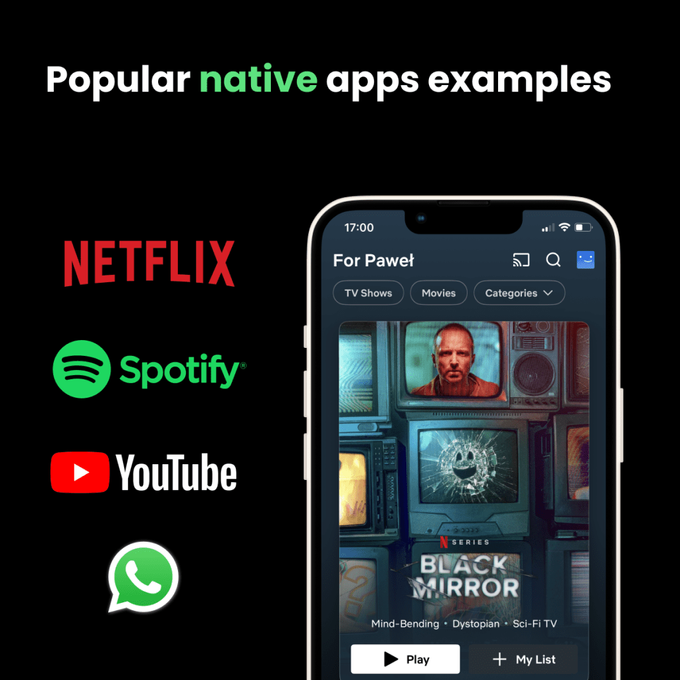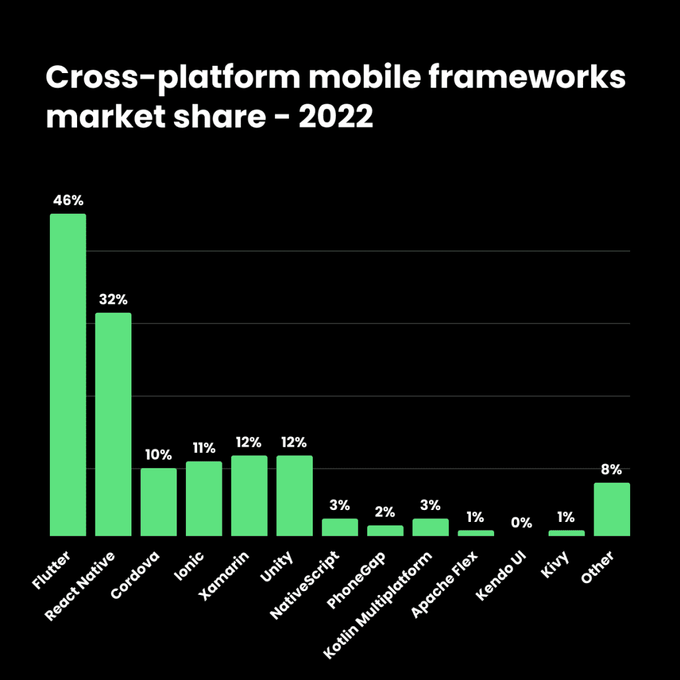Native and hybrid mobile apps: differences, pros and cons

When considering the development of a mobile application, one of the first questions is whether to create it natively or in a hybrid way. Both types have their unique pros and cons, and the choice depends on the specifics of your project, resources, budget, and expected results. In this article, we will examine the main differences between native and hybrid applications.
Native mobile apps
Native applications are created specifically for a particular operating system, such as iOS or Android, using a language specific to that platform (e.g., Swift for iOS, Java, or Kotlin for Android). They require separate lines of code for each platform.
Pros of native applications
- Performance: Native applications are typically faster and more efficient because they are created and optimized for a specific operating system.
- Access to Device Features: Native applications have default access to the operating system's API, allowing them to utilize all native device functions, such as the camera, microphone, GPS, etc. However, it's worth noting that popular hybrid technologies have already developed interfaces for accessing these features.
- UI/UX: Native applications can provide the best user experience as they adhere to the UX/UI guidelines of a specific operating system. However, it's important to note that applications written using hybrid languages like React Native or NativeScript utilize the exact same controls. As a result, it is difficult to distinguish whether an application was developed using a hybrid or native approach solely by its appearance.
- Support and Updates: Native applications have access to the latest updates and features of the operating system immediately after their release. However, it's worth noting that the community around popular hybrid technologies like React Native or Flutter is so vast that the latest updates are typically available without significant delays.
- Security: Native applications can leverage built-in security features of the operating system, making them generally more secure than hybrid applications.
Cons of native applications
- Cost and Development Time: Creating separate versions of an application for each platform can be time-consuming and costly as it requires the use of different technologies and development teams.
- Maintenance: Updates and changes need to be implemented separately for each platform, which can increase the maintenance costs of the application.
- Reach: By creating a native application for only one platform (e.g., only for iOS), you limit your reach to users of that specific operating system.

Native programming languages
Swift
Swift is a programming language developed by Apple that is used for creating native applications for the iOS platform. Swift was introduced in 2014 as a more modern, safe, and efficient alternative to Objective-C, Apple’s previous standard programming language. Swift is known for its readability, speed, and type-safety-based syntax.
Kotlin
Kotlin is a statically typed programming language that is used for creating native applications for the Android platform. Kotlin was introduced by JetBrains and is now officially supported by Google as the preferred language for creating new Android applications. Kotlin is valued for its syntax, which is more concise and expressive than Java, as well as its safety, interoperability with Java, and support for functional programming.
Java
Java is one of the most widely used programming languages in the world and is used for creating native Android applications. Java is known for its strong typing, object-orientation, and portability across different hardware platforms. Even though Kotlin is becoming increasingly popular among Android developers, Java is still widely used, especially in older projects and applications.
Hybrid mobile apps
Hybrid mobile apps are a type of software that combines the features of web apps with the capabilities of native mobile apps. They allow developers to create mobile apps that operate on different platforms while using a single code repository. The “write once, run everywhere” principle makes them attractive to companies wanting to achieve a broader reach with less work.
Pros of hybrid applications
- Cost and Development Time: Creating hybrid mobile apps is usually cheaper and faster as it does not require writing separate codes for each platform.
- Rapid Prototyping: Hybrid apps allow for faster prototyping and testing of ideas, which is crucial for startups and companies that need to bring a product to market quickly.
- Maintenance: Updates and fixes are easier to implement because changes are made in just one place and then propagated to all platforms.
- Cross-Platform Compatibility: Hybrid apps are compatible with various platforms, which allows for increased reach and availability.
Cons of hybrid applications
- Performance: Hybrid apps may not perform as smoothly as native apps, as the additional layer of abstraction between the source code and the target platform can cause delays and slowdowns. While the performance difference may be unnoticeable in simple apps, it can be significant in more complex ones.
- Access to Native Features: While frameworks for creating hybrid apps are getting better at providing native APIs, there may still be some limitations in accessing all the features and capabilities of the native operating system. This can be problematic for apps that need to utilize specific operating system functions.
- User Experience: Hybrid apps may not offer the same intuitive and fluid interactions that native apps provide. This can include elements such as animations, gestures, and even the general behavior of the app, which can differ between platforms. However, it is worth noting that, especially in the case of React Native and Native Script, the differences are often unnoticeable.

Hybrid programming languages (examples)
NativeScript
NativeScript is an open-source framework for creating applications for Android and iOS platforms. It was created by Telerik and is now supported by Progress. The main programming language in NativeScript is JavaScript, but it also supports TypeScript, Vue.js, and Angular. NativeScript allows for direct invocation of native iOS and Android APIs from JavaScript, enabling the creation of apps with performance close to native.
React Native
React Native is a framework created by Facebook that allows for the creation of native mobile apps using JavaScript and React. With React Native, developers can create complex user interfaces with declarative components. React Native can utilize native APIs, enabling the creation of apps with performance close to native apps
Flutter
Flutter is a framework developed by Google for creating applications for multiple platforms, including Android and iOS. Flutter uses the Dart language, which is easy to learn for developers familiar with JavaScript or Java. Flutter allows for the creation of fast, beautiful, and smooth apps that can look and behave like native apps. Flutter is also known for its hot-reloading feature, which allows for immediate viewing of changes in the code while developing apps

Summary
Native apps, written specifically for a particular platform such as Android or iOS, offer excellent performance, smooth user interaction, and full access to device functions by default. However, their development and maintenance can be costly and time-consuming, especially if the app is to operate on multiple platforms.
On the other hand, hybrid apps allow for faster and cheaper development of apps for various platforms using a single source code. While they may be less efficient than native apps, these differences are often so small as to be unnoticeable to the majority of users.
Examples such as Facebook and Instagram, which are hybrid apps, demonstrate that properly designed and implemented hybrid apps are able to deliver quality and experiences comparable to native apps.
From our experience, with the current level of hybrid technology advancement, in the vast majority of projects, they will simply be the better solution. Native technologies should be used only and exclusively when the project’s specifics require high computational power of the device itself, as is the case with apps utilizing streaming (like Spotify, Netflix, or YouTube).
Therefore, the decision to choose between native and hybrid technologies should be based on the specific requirements and constraints of the project.



